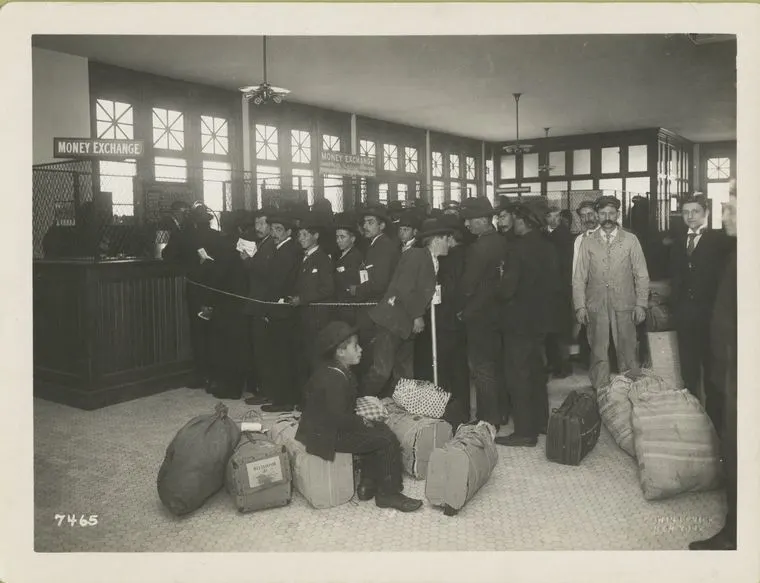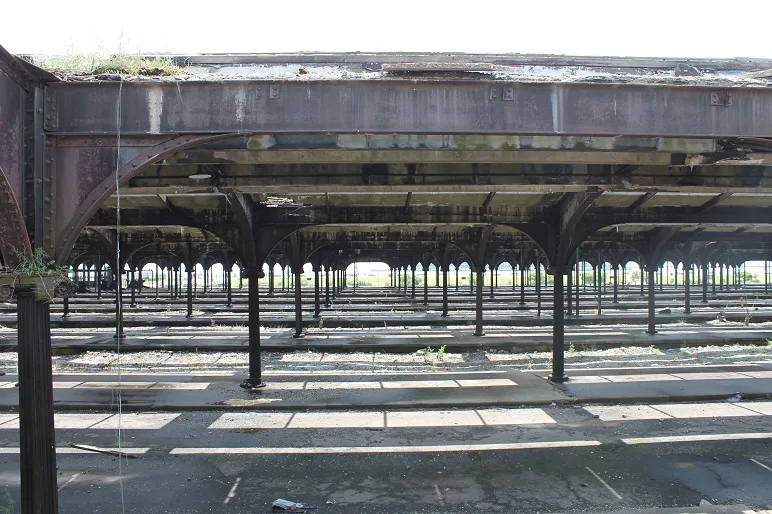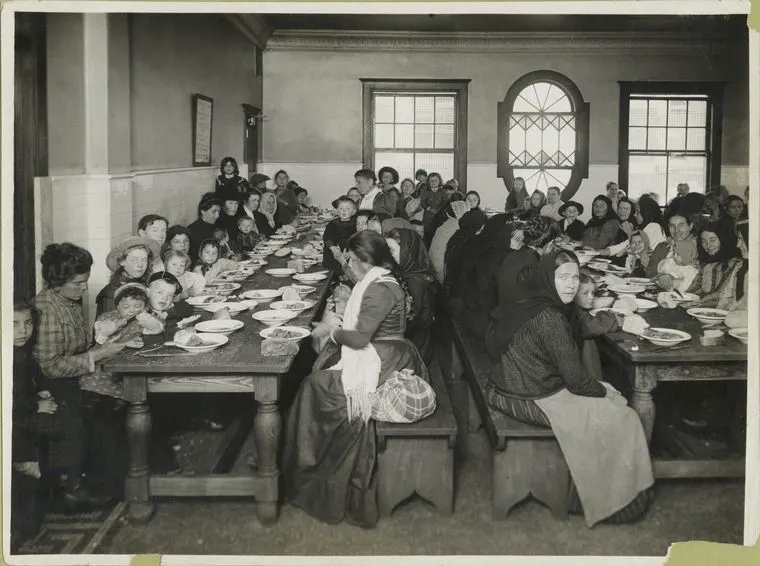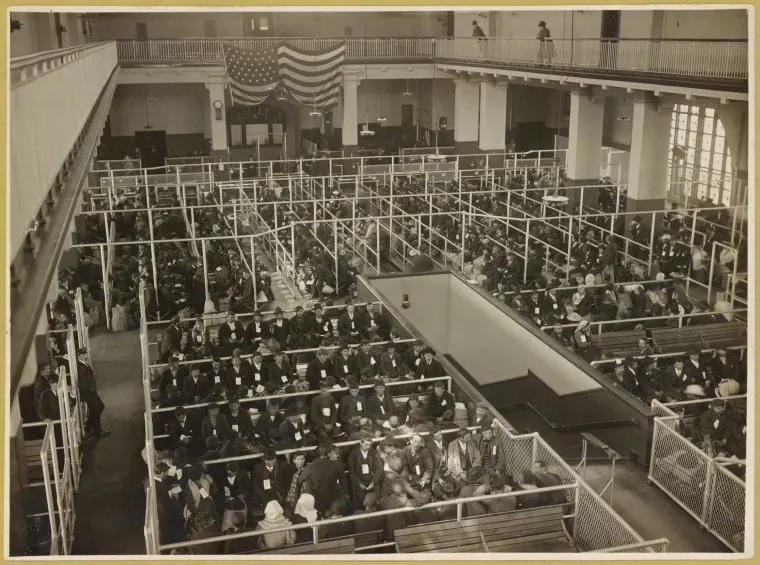Have you ever wondered what your ancestors experienced at Ellis Island during their immigration journey to the United States? In this post, learn what the requirements were for immigrating and what the process was like.

Most of us instinctively know that the modern immigration rules and processes that govern would-be migrants to the United States have changed drastically over the years. While immigrating to the United States has always involved great personal sacrifice, the process historically was much less restrictive than it is today.
Learning about the Ellis Island immigration process is a good way to understand what our ancestors who immigrated to the United States during the late 1800s and early 1900s may have experienced. This is especially true for those of us whose ancestors came into the United States through the New York Harbor.
Did all immigrants have to go to Ellis Island?
Not every immigrant who came to live in the United States through the New York Harbor had to go to through immigration inspection at Ellis Island. Immigrants and other passengers who were traveled first and second class on the ship were taken directly to a pier where they could disembark and go through a customs inspection.
Before the first and second class passengers could leave the ship, however, the ship had to wait in the harbor to be boarded by officials charged with the quarantine inspection, a requirement for every ship entering New York after 1846. This inspection was to make sure that there were no contagious disease outbreaks aboard the ship.
It should be noted that first and second class passengers did have to go to Ellis Island if they were found to be sick by the quarantine inspection officers. However, these passengers were also treated preferentially at Ellis Island or a required health quarantine.
After the quarantine inspection and the drop-off of the wealthier passengers at the piers, the ship would travel to Ellis Island in order to take the steerage passengers to the immigration officials at Ellis Island. This is where immigrants were interviewed and had to pass a medical inspection.
On many occasions, especially for large vessels, a few immigration officers would board the ship immediately after the quarantine inspectors gave it the all-clear in order to get an advanced start on inspecting and questioning immigrants.
Did immigrants need passports or visas at Ellis Island?
There was no official federal law requiring a passport or visa from any immigrant prior to the Immigration Act of 1924. This means that the vast majority of immigrants who passed through Ellis Island, or all immigrants that were processed before 1924, were not required to present a passport, visa, or any other official identity document, during their immigration interviews or inspections.
The fact that our ancestors did not likely need an official documents, such as a passport, to immigrate to the United States is sometimes a disappointing one to discover. I, for one, wish that I could find some of my ancestors’ old passports, but most of my ancestors likely never had a passport issued to them.
An old passport would be a valuable genealogy record, indeed. Since passports were rarely required prior to the 20th century, and many countries did not issue them to everyone, many of our ancestors never received one from their home country’s government.
How long did the immigration process take at Ellis Island?
Most immigrants would only spend about 3-5 hours at Ellis Island. This processing time does not include time spent in the harbor waiting the arrival of the health and quarantine inspectors, or the time that it took to drop off the first and second class passengers that were not required to go through Ellis Island.
Ships were not able to dock directly at Ellis Island because the water is too shallow. Thus, once all of the first and second class passengers were unloaded, the steerage passengers were checked by customs officers and then loaded into smaller ships that traveled across the harbor, usually from Manhattan, to Ellis Island.
What were the steps of the Ellis Island immigration process?
The first part of the immigration process was usually a medical inspection. This inspection was done by military doctors who were often dressed in military uniforms.
These doctors looked for common illnesses, deformities, and mental problems that would cause the immigrant to be a burden to the public. Immigrants who did not pass the first medical inspection, which eventually became known as the “six second” inspection, were referred to a secondary medical inspection which took longer.
The second part of the inspection was the “interview”. Immigrants were formed into long lines after the medical inspection for this part of the process.
The immigration official who was conducting the interviews would, often with the help of interpreters, examine the passenger manifest that was provided by the shipping company. The immigrants were asked questions about themselves, and if the information matched with what the manifest said, they were usually done with their immigration process at that time.
Immigrants were also questioned about religion, political ideologies, among other general questions. Occasionally, an immigrant gave unsatisfactory answers and was referred for a more thorough, secondary questioning.

Once an immigrant had completed both the medical inspection and the interview, they could purchase a train ticket and take a ferry from Ellis Island to the Central Railroad of New Jersey Terminal. This means that for most immigrants who passed through Ellis Island, the first steps that they took on United States mainland soil was actually in New Jersey and not New York.
After the immigrant arrived to the train terminal, they would take their train to wherever their final destination was and start their new life in their new country.

The photograph above shows where the trains once arrived and departed at the New Jersey rail terminal. You can imagine the exhaustion and excitement of our ancestors upon arrival here.
How selective were immigration officers at Ellis Island?
Once most immigrants arrived at Ellis Island, the hardest part of their journey was done. Immigration officials were not especially selective, especially compared with today’s standards, meaning that it was easier to be allowed to legally enter the United States permanently than it is today.
As long as a male immigrant looked healthy, appeared to be of sound mind, and seemed to have a good chance at finding gainful employment in the future, they were likely to be admitted to the United States.

Immigration workers at Ellis Island were stressed and overworked, since they had to process thousands of immigrants each day. The busiest day ever on Ellis Island saw more than 11,000 immigrants, and most days saw at least several thousand.
This means that the immigration officials were busy and under a lot of pressure to interview, inspect, and otherwise move a large number of people in and out of Ellis Island.
Female immigrants, especially those traveling with young children, had a more difficult time passing the Ellis Island immigration interviews and inspections. Women and children traveling alone were subjected to tougher scrutiny, and were often not allowed to leave Ellis Island without a male relative as an escort.
Even though the immigration process wasn’t especially selective, the journey from Europe to North America wasn’t easy. As many as 10% of those who made it onto a ship headed to America died on board, though the exact number of deaths were not tracked.
If a total of 12 million immigrants were processed by Ellis Island and the 10% estimate is true, then we can extrapolate the data to estimate that as many as 1.3 million immigrants died attempting to immigrate to the United States during the time of the immigration center’s operation.
This number does not include the estimated 3500 immigrants who died on Ellis Island, either while in detention, quarantine, or waiting for their immigration process to conclude.

How many immigrants were denied at Ellis Island?
Only about 2% of total immigrants who arrived at Ellis Island were eventually denied entry and deported back to their home country. In real numbers, the amount of people who were sent home amounted to approximately 120,000 people.
About 12 million people passed through Ellis Island on their way to establish a new life in the United States. Since only about 120,000 people were denied entry, you can see that the process was not very restrictive.
In other words, our ancestors should not have been too worried that they would be denied the chance to come into the United States once they arrived at the island. This is not to mean that the entire process was not very stressful and scary for them, of course.
Their dangerous, stressful, and emotional journey was almost over, especially for those who planned to stay in the greater New York City region.
Why were immigrants denied entry at Ellis Island?
Of the immigrants who were denied entry at Ellis Island, the reasons included having a higher chance of being a public charge, having “low moral character”, appearing obviously ill, being an anarchist, not being perceived intelligent or strong enough to find a job, or having a criminal record. Even though many of these requirements were objectively subjective, we know that relatively few immigrants were denied entry.
The main concern of immigration officials at Ellis Island was that potential immigrants not be likely to be a “public charge”. In the 19th century, a public charge meant that the person would not be able to financially support themselves and their dependents.
At this point in history, there was little available in the form of financial assistance from the federal and state governments, so the concern was that immigrants who were more likely to be a public charge would not contribute positively to the economy. During this time period, who needed financial help would also end up turning to the average citizen to ask for handouts in the form of money or food, thus the term “public charge”.
Nowadays, the definition of public charge in terms of immigration has changed to include certain types of government assistance. Most modern-day permanent immigrants to the United States must have a US sponsor who can prove an income high enough to provide for their own family, as well as the immigrant and any dependents for a period of ten years – a high bar.
This was not a requirement in the age of Ellis Island. Certainly some of these would-be immigrants may have been allowed entry had the sponsorship process been in the place at the time.
It should also be mentioned that at least 3500 immigrants died while they were at Ellis Island. Some of these individuals arrived with illness, but there were also instances of immigrants becoming sick in the unsanitary conditions on the island, especially if they were detained for any number of days or weeks past the customary 3-5 hour processing time.
Did immigrants get their names changed at Ellis Island?
Most immigrants left Ellis Islands with their names exactly as they were in their native country. Immigration officials did not change the names of immigrants, as a general rule.
Most of us who have done genealogy research have noticed that some of our ancestors might have established a life in the United States with a name that is a different version, or has a different spelling, than the name that they were given at birth.
The most common reason that we notice differences between spellings in American records versus records from their home country is due to errors or miscommunication with the ticket clerk in the country where their passage to the United States was purchased. The name of the person traveling was written down on the ship passenger list, and this was the name that was used during the immigration process.
If the clerk may have spelled the name incorrectly. Miscommunications due to the clerk and the traveler speaking different languages were common as well.
Because many of our ancestors had limited English skills and may not have a good understanding of the immigration process at Ellis Island, they may have been under the impression that the immigration official was responsible for any name discrepancies. This might be the reason that many families, including my own, have stories about names being changed by immigration officers at Castle Garden or Ellis Island.
Once an immigrant arrived at their destination, they may have decided to change their name to be able to fit in with their new community, draw less attention to themselves, or have a name that was easier for English speakers to pronounce. This was sometimes done informally, but legal name changes could also be done as part of the formal naturalization (citizenship) application process.
Legal name changes continue to be available to new citizens of the United States, but fewer people take advantage this little-known option. Nowadays, when someone applying for citizenship hopes to change their name once they become a citizen, they put the name that they would like on their naturalization application.
Once their application is approved and their certificate of naturalization is issued at their oath ceremony, their name change is official.
Prior to 1906, citizenship applications were handled by numerous different courts across the country. Each jurisdiction had different rules and procedures, and many naturalization requests processed through these various courts involved name changes.
However, often times the name change was not defined as a name change because the citizenship application was submitted under the “new” name, with new papers being issued under the immigrant’s chosen name.
No matter exactly how these immigrants got their names changed, it did not happen at Ellis Island.
Did all immigrants have to pass through Ellis Island?
No, not all immigrants to the United States passed through Ellis Island while the immigration station was in operation. There were many other ports of entry to the United States, including Boston, San Fransisco, New Orleans, Baltimore, and Philadelphia.
In addition, not everyone who traveled into New York Harbor had to go through the Ellis Island inspection process. The immigration officials only processed those passengers who traveled in steerage, the cheapest ticket type, as well as sick passengers of those with a criminal accusations.
Those passengers who could afford to travel to the US through the New York port on a first or second class ticket, which may have cost around £25 in 1890 (about $3500 in 2023 USD), were assumed to be affluent enough to support themselves in the United States. Steerage rates were much less expensive, with tickets for Irish immigrants, for example, costing about £4 per person in 1890 (about $750 in 2023 USD).
Conclusion
I hope that this post has helped you understand more about what the immigration process was like for our ancestors. It has certainly changed a lot over the years and does not bear much resemblance to our modern immigration methods.
If you have any question about something that you read in this post, or if you want to share a story about one of your ancestors who came through the Ellis Island immigration station, please be sure to join the discussion below.
Thanks for stopping by and reading today.
